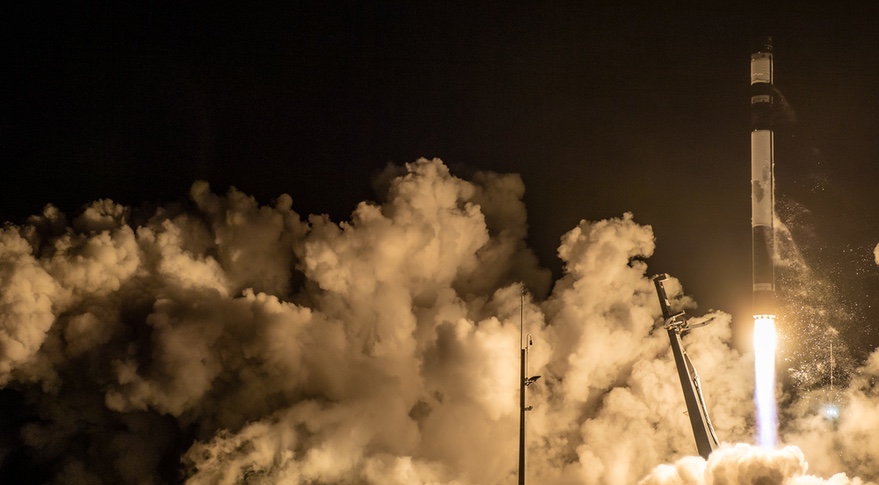WASHINGTON — A Rocket Lab Electron rocket launched a satellite Oct. 7 carrying a payload for U.S. and French government agencies that will track wildlife and collect other sensor data.
The Electron lifted off from Pad B at Launch Complex 1 in New Zealand at 1:09 p.m. Eastern. The two-stage rocket deployed a kick stage into orbit nine minutes later. After an extended coast, the kick stage fired its Curie engine then deployed its payload, the GAzelle satellite, into a 750-kilometer sun-synchronous orbit about 55 minutes after liftoff.
GAzelle was built by General Atomics as part of a complex set of relationships among several government agencies. The U.S. Space Force’s Space Systems Command selected General Atomics to host the Argos Advanced Data Collection System payload through its Hosted Payload Services contract vehicle, on behalf of the National Oceanic and Atmospheric Administration, at a cost of $64 million.
The GAzelle spacecraft, weighing about 110 kilograms, hosts the Argos-4 instrument, provided by the French space agency CNES, as part of the Argos program that includes NOAA, NASA and other national space agencies. Argos payloads on satellites collect and relay data from sensors worldwide, primarily those that track wildlife.
The Argos program dates back to the 1970s, with Argos-4 representing the most advanced receivers yet flown. Sophie Coutin-Faye, head of the Argos program office at CNES, said at a Sept. 27 media briefing that Argos-4 covers a wider frequency band and has greater data transmission capacity.
“These improvements and the expanded coverage that the upcoming launches will provide will make it easier for current and new users to collect more data, from many more beacons, across the globe and with much better data timeliness,” she said.
Argos is most commonly used for wildlife tracking because of its low power requirements. “No other satellite system has the same global coverage, supports very small, low powered transmitters, and has transmissions that require less than one second,” said Melinda Holland, chief executive of Wildlife Computers, which provides Argos telemetry instruments for marine animal studies, at the briefing.
“This makes Argos the only currently available satellite system suitable for briefly surfacing marine animals such as whales, seals and sea turtles, and even non-air breathing animals such as billfish, sharks and rays,” she added.
Electron and Neutron plans
The launch was the eighth this year for Rocket Lab and the 31st launch overall for the Electron rocket. The company did not immediately disclose the schedule for its next launch.
At a Sept. 21 investor day event, Rocket Lab said it was proceeding with plans for its first Electron launch from Launch Complex 2 at Wallops Island, Virginia, in December. That launch will carry satellites for HawkEye 360, which operates a constellation of satellites to perform radio-frequency tracking.
Rocket Lab had hopes to start launching from Virginia in 2020, but was delayed by a lengthy NASA certification process for the rocket’s autonomous flight termination system, or AFTS, needed for launches from Wallops. “We have absolute assurances from NASA that the AFTS will be complete on time,” said Peter Beck, chief executive of Rocket Lab, at the investor day event. “After nearly a two-year delay on that, we’re super excited to get this first vehicle launched off LC-2 by the end of the year.”
Beck disclosed at the event that the company signed a second, confidential customer for an Electron launch from LC-2 in January. “Basically, we’ll have one out of December, one in January, and that LC-2 launch site will be well and truly kicked off and up and running,” he said.
Much of the event was devoted to an update on Neutron, the medium-class reusable launch vehicle that the company announced in 2021. “We are building this thing,” Beck said, pointing to work on tooling to produce the tanks for the vehicle. “There’s real hardware coming, and this is an exciting time.”
While initially billed as a vehicle capable of placing up to eight tons into orbit, Beck said that is for the version that returns to land at the launch site. That performance increases to 13 tons for missions that land on a barge downrange from the launch site, and 15 tons if the vehicle is expended.
Rocket Lab also changed the design of Neutron’s fairing, which opens to release the upper stage then closes and remains attached to the vehicle. The fairing now opens in two panels rather than four. “We made that change to just reduce part counting and complexity,” Beck said.
The vehicle now has nine Archimedes engines in its first stage, up from seven in the original design. Those engines, Rocket Lab announced, will be tested at a facility it is leasing at NASA’s Stennis Space Center in Mississippi. Construction is underway on the factory adjacent to the Wallops Flight Facility where Rocket Lab will assemble Neutron rockets, which will be launched from a new pad, Launch Complex 3, at Wallops.
Beck also used the presentation to tease a possible human spaceflight project, showing renderings of a capsule atop a Neutron rocket and docking with the International Space Station. He said the company was not announcing plans to develop such a capsule, but didn’t rule out doing so in the future.
“The vehicle is designed to be human-ratable. You don’t design a vehicle like this without that mind,” Beck said of Neutron. “We don’t have any particular programs focusing on capsules, but we’re looking at it.”
